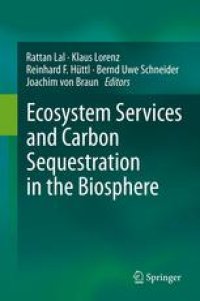
Ebook: Ecosystem Services and Carbon Sequestration in the Biosphere
- Tags: Agriculture, Soil Science & Conservation, Environment general, Climate Change, Sustainable Development
- Year: 2013
- Publisher: Springer Netherlands
- Edition: 1
- Language: English
- pdf
Ecological functions and human wellbeing depend on ecosystem services. Among the ecosystem services are provisional (food, feed, fuel, fiber), regulating (carbon sequestration, waste recycling, water cleansing), cultural (aesthetic, recreational, spiritual), and supporting services (soil formation, photosynthesis, nutrient cycling). Many relationships of various degree exist among ecosystem services. Thus, land use and soil management to enhance biospheric carbon sinks for carbon sequestration requires a comprehensive understanding on the effects on ecosystem services. Payments for ecosystem services including carbon pricing must address the relationship between carbon sequestration and ecosystem services to minimize risks of overshoot, and promote sustainable use of land-based carbon sinks for human wellbeing.
This book describes comprehensively potential, co-benefits and drawbacks of carbon (C) sequestration for ecosystem services. Soil generates numerous ecosystem services for human wellbeing and ecological functions. The services discussed include provisional (feed, food, timber, biofuel), regulating (carbon sequestration, pests, diseases), cultural, and supporting (soil formation, nutrient cycling) services. Recarbonization of the biosphere is a potential strategy to redistribute C among global pools, and to enhance ocean but most importantly land-based C sinks with possible feedback on soil-based ecosystem services. Land use and soil management can degrade soil quality, and either reduce quantity and quality of ecosystem services or lead to disservices and create large ecological footprint. Thus, trade-offs between carbon sequestration and ecosystem services must be considered when incentivizing land managers through payments for ecosystem services. Together with sustainable management of land-based C sinks for climate change adaptation and mitigation this will minimize the risks of recarbonization of the biosphere for ecological functions and human wellbeing.
This book describes comprehensively potential, co-benefits and drawbacks of carbon (C) sequestration for ecosystem services. Soil generates numerous ecosystem services for human wellbeing and ecological functions. The services discussed include provisional (feed, food, timber, biofuel), regulating (carbon sequestration, pests, diseases), cultural, and supporting (soil formation, nutrient cycling) services. Recarbonization of the biosphere is a potential strategy to redistribute C among global pools, and to enhance ocean but most importantly land-based C sinks with possible feedback on soil-based ecosystem services. Land use and soil management can degrade soil quality, and either reduce quantity and quality of ecosystem services or lead to disservices and create large ecological footprint. Thus, trade-offs between carbon sequestration and ecosystem services must be considered when incentivizing land managers through payments for ecosystem services. Together with sustainable management of land-based C sinks for climate change adaptation and mitigation this will minimize the risks of recarbonization of the biosphere for ecological functions and human wellbeing.
Content:
Front Matter....Pages i-x
Societal Dependence on Soil’s Ecosystem Services....Pages 1-10
Soils and Ecosystem Services....Pages 11-38
Ecosystem Carbon Sequestration....Pages 39-62
Food Security Through Better Soil Carbon Management....Pages 63-78
Soil Carbon and Water Security....Pages 79-99
Forests, Carbon Pool, and Timber Production....Pages 101-130
Ecosystem Carbon and Soil Biodiversity....Pages 131-153
Ecosystem Services and the Global Carbon Cycle....Pages 155-181
Loss of Soil Carbon to the Atmosphere via Inland Surface Waters....Pages 183-208
Why Pests and Disease Regulation Should Concern Mankind....Pages 209-220
Natural Hazards Mitigation Services of Carbon-Rich Ecosystems....Pages 221-293
Preserving Regulating and Cultural Ecosystem Services: Transformation, Degradation and Conservation Status....Pages 295-312
Human Appropriation of Net Primary Production, Stocks and Flows of Carbon, and Biodiversity....Pages 313-331
Soil Carbon and Biofuels: Multifunctionality of Ecosystem Services....Pages 333-356
Land Degradation and Ecosystem Services....Pages 357-381
The Human Dimensions of Environmental Degradation and Ecosystem Services: Understanding and Solving the Commons Dilemma....Pages 383-405
Soil Organic Carbon, Soil Formation and Soil Fertility....Pages 407-418
Managing Soil Organic Carbon for Advancing Food Security and Strengthening Ecosystem Services in China....Pages 419-429
Research and Development Priorities for Global Soil-Related Policies and Programs....Pages 431-455
Back Matter....Pages 457-464
This book describes comprehensively potential, co-benefits and drawbacks of carbon (C) sequestration for ecosystem services. Soil generates numerous ecosystem services for human wellbeing and ecological functions. The services discussed include provisional (feed, food, timber, biofuel), regulating (carbon sequestration, pests, diseases), cultural, and supporting (soil formation, nutrient cycling) services. Recarbonization of the biosphere is a potential strategy to redistribute C among global pools, and to enhance ocean but most importantly land-based C sinks with possible feedback on soil-based ecosystem services. Land use and soil management can degrade soil quality, and either reduce quantity and quality of ecosystem services or lead to disservices and create large ecological footprint. Thus, trade-offs between carbon sequestration and ecosystem services must be considered when incentivizing land managers through payments for ecosystem services. Together with sustainable management of land-based C sinks for climate change adaptation and mitigation this will minimize the risks of recarbonization of the biosphere for ecological functions and human wellbeing.
Content:
Front Matter....Pages i-x
Societal Dependence on Soil’s Ecosystem Services....Pages 1-10
Soils and Ecosystem Services....Pages 11-38
Ecosystem Carbon Sequestration....Pages 39-62
Food Security Through Better Soil Carbon Management....Pages 63-78
Soil Carbon and Water Security....Pages 79-99
Forests, Carbon Pool, and Timber Production....Pages 101-130
Ecosystem Carbon and Soil Biodiversity....Pages 131-153
Ecosystem Services and the Global Carbon Cycle....Pages 155-181
Loss of Soil Carbon to the Atmosphere via Inland Surface Waters....Pages 183-208
Why Pests and Disease Regulation Should Concern Mankind....Pages 209-220
Natural Hazards Mitigation Services of Carbon-Rich Ecosystems....Pages 221-293
Preserving Regulating and Cultural Ecosystem Services: Transformation, Degradation and Conservation Status....Pages 295-312
Human Appropriation of Net Primary Production, Stocks and Flows of Carbon, and Biodiversity....Pages 313-331
Soil Carbon and Biofuels: Multifunctionality of Ecosystem Services....Pages 333-356
Land Degradation and Ecosystem Services....Pages 357-381
The Human Dimensions of Environmental Degradation and Ecosystem Services: Understanding and Solving the Commons Dilemma....Pages 383-405
Soil Organic Carbon, Soil Formation and Soil Fertility....Pages 407-418
Managing Soil Organic Carbon for Advancing Food Security and Strengthening Ecosystem Services in China....Pages 419-429
Research and Development Priorities for Global Soil-Related Policies and Programs....Pages 431-455
Back Matter....Pages 457-464
....